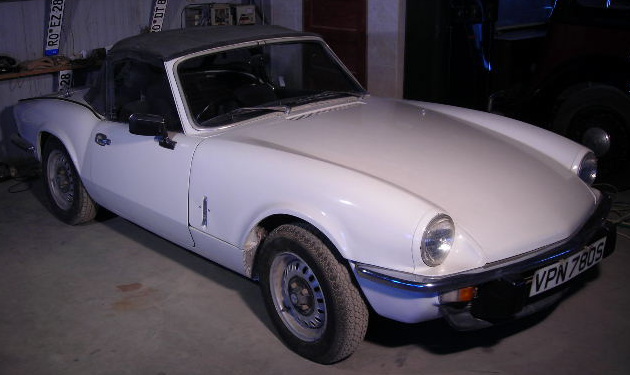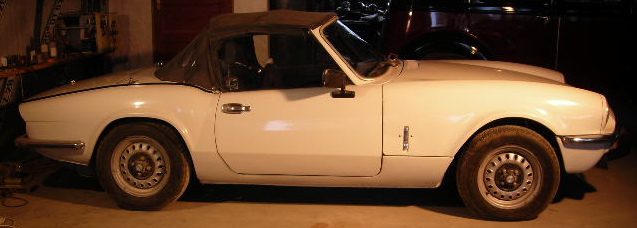This one is the last Spitfire, made in 1978.
| Date of manufacture: | 1978 |
| Production Years: | 1961 – 1980 |
| Produced: | 314200 total |
| 95,829 Spitfires 1500 | |
| Country of origin: | England |
| Manufacturer: | Triumph Motor Company |
| Designer: | Giovanni Michelotti |
| Engine capacity: | 1493 cc |
| Power Output: | 71 bhp = 53 kW |
| Top Speed: | 100 mph = 160 km/h |
| Price then: | $5,995 for the 1980 Model. |
In 1973 in the United States and Canada, and 1975 in the rest of the world, the 1500 engine was used to make the Spitfire 1500. Although in this final incarnation the engine was rather rougher and more prone to failure than the earlier units, torque was greatly increased by increasing the cylinder stroke to 87.5 mm (3.44 in), which made it much more drivable in traffic. The reason for the engine problems was the continued use of three main bearings for the crankshaft.
use of three main bearings for the crankshaft.
While the rest of the world saw 1500s with the compression ratio reduced to 8.0:1, the American market model was fitted with a single Zenith-Stromberg carburettor and a compression ratio reduced to 7.5:1 to allow it to run on lower octane unleaded fuel, and after adding a catalytic converter and exhaust gas recirculating system, the engine only delivered 53 bhp (40 kW) with a fast 0–60 time of 14.3 seconds. The notable exception to this was the 1976 onwards model year, where the compression ratio was raised to 9:1.
In the UK the 9:1 compression ratio, less restrictive emissions control equipment, and the Type HS2 SU carburettors now being replaced with larger Type HS4 models, led to the most powerful variant to date. The 1500 Spitfire now produced 71 bhp (53 kW) at 5500 rpm, and produced 82 ft·lb (111 N·m) of torque at 3000 rpm. Top speed was now at the magical 100 mph (160 km/h) mark, and 0 to 60 mph (97 km/h) was reached in 13.2 seconds. Fuel economy was reduced to 29mpg.
The American market Spitfire 1500 is easily identified by the big plastic over-riders and wing mounted reflectors on the front and back wings. The US specification models up to 1978 still had chrome bumpers, but on the 1979 and 1980 models these were replaced by black rubber bumpers with built-in over-riders. Chassis extensions were also fitted under the boot to support the bumpers.
Detail improvements continued to be made throughout the life of the Mark IV, and included reclining seats with “chequered brushed nylon centre panels” and head restraints, introduced for domestic market cars early in 1977 along with a new set of column stalk operated minor controls (as fitted already in theTR7) replacing the old dashboard mounted knobs and switches. Also added for the model’s final years were a wood dash, hazard flashers and an electric screen washer, in place of the previous manual pump operated ones. Options such as the hard top, tonneau cover, map light and overdrive continued to be popular, but wire wheels ceased to be available.
to be made throughout the life of the Mark IV, and included reclining seats with “chequered brushed nylon centre panels” and head restraints, introduced for domestic market cars early in 1977 along with a new set of column stalk operated minor controls (as fitted already in theTR7) replacing the old dashboard mounted knobs and switches. Also added for the model’s final years were a wood dash, hazard flashers and an electric screen washer, in place of the previous manual pump operated ones. Options such as the hard top, tonneau cover, map light and overdrive continued to be popular, but wire wheels ceased to be available.
The 1980 model was the last and the heaviest of the entire run weighing in at 1,875 lb (850.5 kg). Base prices for the 1980 model year were $5,995 in the US and £3,631 in the UK. The last Spitfire, an Inca Yellow UK-market model with hardtop and overdrive, rolled off the assembly line at Canley in August 1980, shortly before the factory closed. It was never sold and is now displayed at the British Motor Heritage museum at Gaydon.




